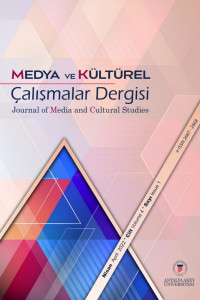Bir Cemaat İmkanı ve Direniş Alanı Olarak Sahne: Pose Üzerine Bir İnceleme
Kesişimsel kimliklere ait farklı insan profillerini bir araya getiren Pose'u(Ryan Murphy, 2018), Amerikan balo kültürüne dair bir kurgu olmasının ötesinde, kimlik politikalarına ve direkt olarak kimlik meselesine başkaldıran bir tekillik savunması olarak okumak mümkündür. Pose'daki daima ötekileştirilen karakterler, yalnızca kılık değiştirerek, makyaj yaparak, dans ederek ve poz vererek bir arada olabildikleri balo gecelerinde bir özgürleşme fırsatı bulurlar. Bu özgürleşme fırsatı, aynı zamanda onların kim olduklarına dair gerçeği yeniden kurmak için sahip oldukları fırsattır. Bu çalışmanın amacı, Pose'u kimlik ve tekillik problemi etrafında şekillenmiş bir proje, tahakküm altındaki insanların nasıl kendi tekilliklerini kurabileceğine ve nasıl bir cemaat haline gelebileceğine dair bir önerme olarak değerlendirmektir. Bu amaç doğrultusunda, çalışmanın ilk kısmında Pose'un kimlik ve özne problemi ile kurduğu organik bağ incelenerek dizide açıkça ortaya koyulan tahakküm mekanizmaları(örneğin kurumlar ve kültürel normlar) Foucault'un teorize ettiği söylem pratikleri bağlamında analiz edilmiştir. Ayrıca dizide vurgulanan AİDS salgını ve salgının egemen kuruluşlar tarafından tanımlanma biçimleri tahlil edilmiştir. İkinci kısımda, Pose'da tahakküm edilen insanların bir cemaate dönüşme süreci ve bu süreçte ölümün nasıl bir rol oynadığı Nancy ve Blanchot gibi bazı düşünürlerin öne sürdüğü fikirler çerçevesinde incelenmiştir. Üçüncü kısımda, Agamben’in cemaate ve siyasal istisna durumlarına dair görüşleri ve homo sacer terminolojisi Pose üzerinden değerlendirilmiştir. Sonuç olarak Pose'un kimlik ve cemaat kuramları açısından son derece zengin bir kurguya sahip olduğuna, bu kurgunun ve kurguda sıkça değinilen poz verme jestinin "kendiliğin dışavurumu aracılığıyla başkalarıyla birlikte olmak" temasını açığa çıkardığına, bir direniş alanı haline gelen sahne üzerinde hem tekilliğin hem de cemaatin bir karşı duruş olarak yeniden ve daima yeniden oluşturulduğuna kanaat getirilmiştir.
The Stage as a Community Possibility and a Space of Resistance: A Study on Pose
It is possible to read Pose (Ryan Murphy, 2018), which brings together different human profiles belonging to intersectional identities, as a defense of singularity that rebels against identity politics and directly the issue of identity, beyond being a fiction about American ball culture. The always marginalized characters in Pose find an opportunity for liberation on prom nights, where they can only be together by disguising, putting on makeup, dancing and posing. This opportunity for liberation is also their opportunity to reconstruct the truth about who they are. The purpose of this study is to evaluate Pose as a project shaped around the problem of identity and singularity, a proposition about how people under domination can establish their own singularity and how they can become a community. For this purpose, in the first part of the study, Pose's organic connection with the identity and subject problem was examined, and the mechanisms of domination (for example, institutions and cultural norms) that were clearly revealed in the series were analyzed in the context of discourse practices theorized by Foucault. In addition, the AIDS epidemic emphasized in the series and the way the epidemic was defined by the dominant institutions were analyzed. In the second part, the process of transforming people who are dominated in Pose into a community and the role of death in this process are examined within the framework of the ideas put forward by some thinkers such as Nancy and Blanchot. In the third part, Agamben's views on community and political exceptions and homo sacer terminology are evaluated through Pose. It has been concluded that Pose has a very rich fiction in terms of identity and community theories, and that the gesture of posing, which is frequently mentioned in this fiction, reveals the theme of "being with others through self-expression", and that both the singularity and the community are a part of the stage, which has become a field of resistance and reconstructed as a counter-stance.
___
- Acı, O. (2021). Televizyonda kesişimsellik: Pose dizisindeki siyahi trans kadınların alımlanması. Strata, (7).
- Agamben, G. (2004). Auschwitz’den artakalan. (Çev. A. İ. Başgül). Ankara: Kitle Yayıncılık.
- Agamben, G. (2006). İstisna hali. (Çev. K. Atakay). İstanbul: Otonom Yayıncılık.
- Agamben, G. (2007). The coming community. (Çev. M. Hardt). Minneapolis: University of Minnesota Press.
- Agamben, G. (2012a). Dispozitif nedir?/Dost. (Çev. E. Dedeoğlu). İstanbul: Monokl Yayınları.
- Agamben, G. (2012b). Gelmekte olan ortaklık. (Çev. B. Parlak). İstanbul: Monokl Yayınları.
- Agamben, G. (2013). Kutsal insan: egemen iktidar ve çıplak hayat. (Çev. İ. Türkmen). İstanbul: Ayrıntı Yayınları.
- Akalin, A. (2015). Tekillik tartışmasında öz sorunu. (Yayımlanmamış yüksek lisans tezi). Sosyal Bilimler Enstitüsü: İstanbul Bilgi Üniversitesi
- Baştürk, E. (2013). Bir kavram iki düşünce: Foucault’dan Agamben’e biyopolitikanın dönüşümü. Alternatif Politika, 5(3), 242-265.
- Blanchot, M. (1997). itiraf edilemeyen cemaat. (Çev. I. Ergüden). İstanbul: Ayrıntı Yayınları.
- Faubion, J., & Rabinow, P. (Eds.). (1998). "Nietzsche, genealogy, history", aesthetics, method and epistemology içinde. New York: The New Press.
- Foucault, M. (1984). What is enlightenment?. the Foucault reader içinde (32-50. ss). New York: Pantheon Books.
- Foucault, M. (2000). Özne ve iktidar. (Çev. I. Ergüden, O. Akınhay). İstanbul: Ayrıntı Yayınları.
- Foucault, M. (2012). Cinselliğin tarihi. (Çev. H. U. Tanrıöver). İstanbul: Ayrıntı Yayınları.
- Nancy, J. L. (1991). The inoperative community. (Çev. P. Connor, L. Garbus). Minneapolis: University of Minnesota Press.
- Nancy, J. L. (2000). Being singular plural. (Çev. R. D. Richardson, A. E. O'byrne). California: Stanford University Press.
- Yağbasan, E. B. (2017). İstisnalar kaideyi bozar mı? Agamben ve çıplak hayat. Mersin Üniversitesi Sosyal Bilimler Enstitüsü Dergisi, 1(1), 9-16.
